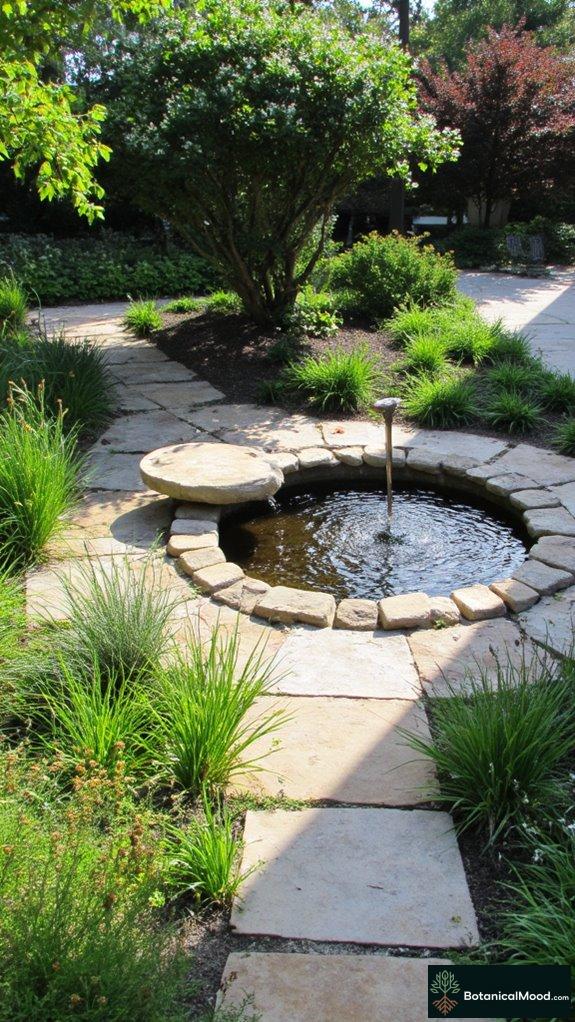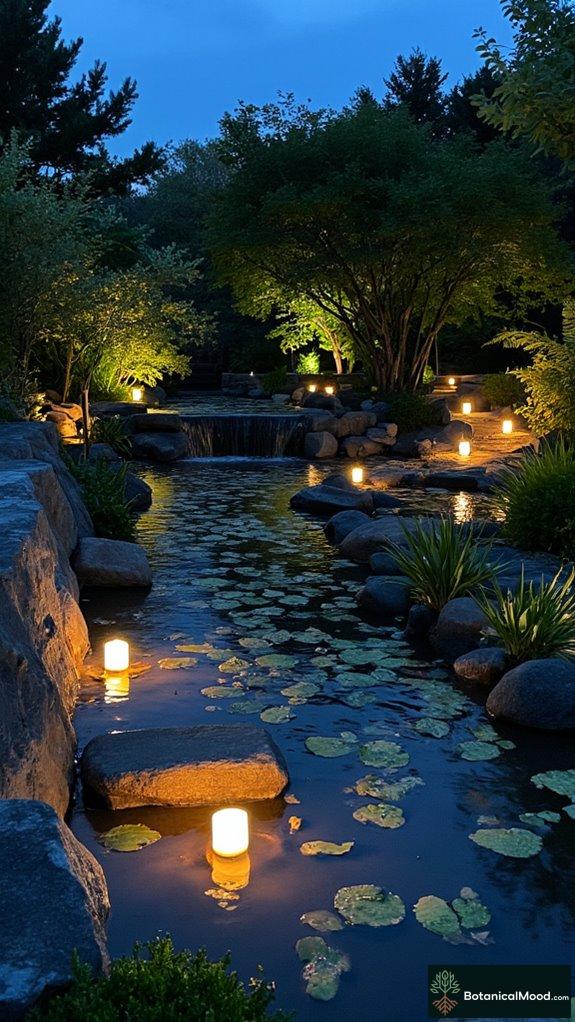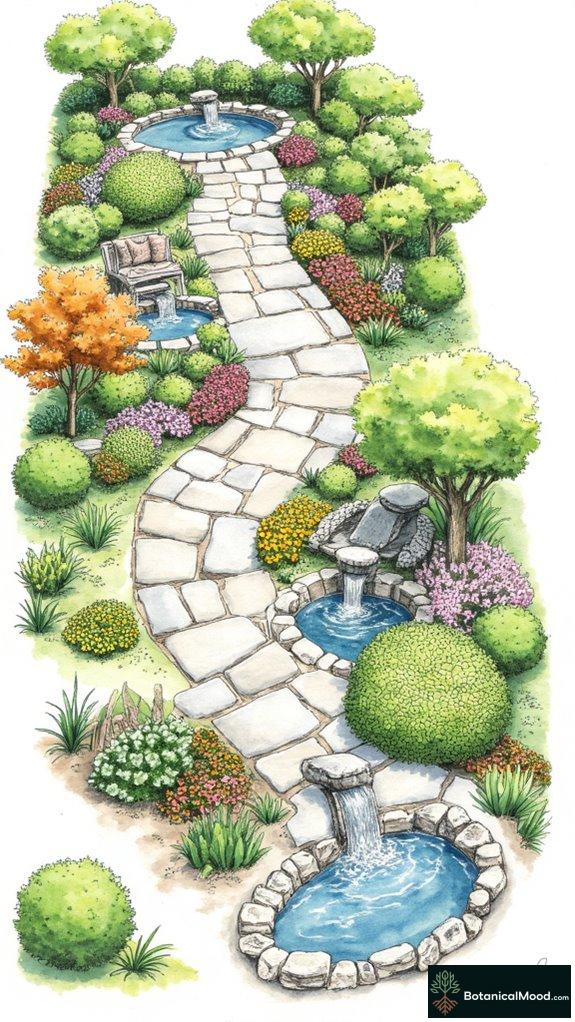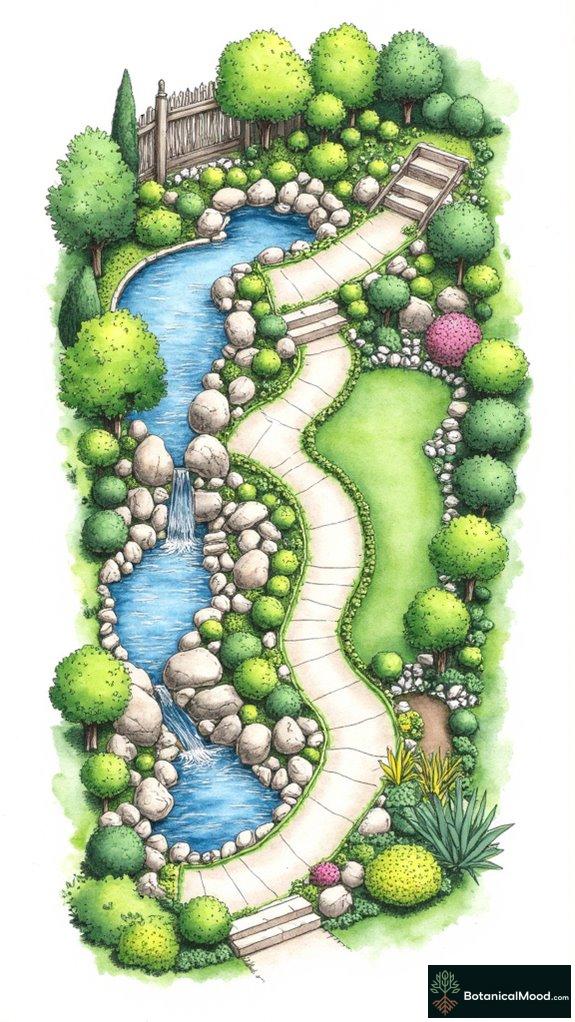Want to transform that sloped patch of doom into a lush paradise?
Well, that’s exactly what I did! After battling with erosion like it was a villain in a superhero movie, I decided to try eco-friendly terracing techniques.
Armed with sustainable timber and a love for native plants like Lavender and Agave, my garden’s now a resilient little ecosystem.
And guess what? French drains aren’t just fancy drainage; they’re my plant’s lifeline. Whoever knew gardening could stir such admiration (and a sprinkle of sarcasm), right?
Let’s embrace the charm of our little green projects—imperfect yet beautiful!
When Design Meets Disaster: My Garden Redemption Journey
I remember the first time I tried to beautify my garden. I was excited but, oh boy, was I clueless! I created chaos instead of charm—mudslides and dying plants were my new normal.
One April afternoon, after losing half my less-than-willing Agaves to an unexpected downpour, I realized I needed to rethink my approach. That’s when I dived into terracing and sustainable landscaping.
Fast forward: my garden is now a glorious tapestry of biodiversity. By layering planting beds and choosing native flora, I’ve seen butterflies, bees, and the occasional inquisitive squirrel return to reclaim their territory.
Each plant tells a story of resilience, and every drip from my French drains signals hope for my little patch of earth.
Quick Takeaways
- Implement terracing to combat soil erosion and enhance visual appeal while promoting biodiversity.
- Select durable materials like stone and treated timber to ensure effective slope support and drainage solutions.
- Incorporate native and drought-tolerant plants to create resilient ecosystems and reduce water usage.
- Utilize innovative drainage techniques, such as French drains, to manage water efficiently and prevent erosion.
- Draw inspiration from global terraced landscapes to create aesthetic and sustainable gardening practices tailored to local conditions.
Understanding the Importance of Terraced Gardens

When we consider the beauty and functionality of terraced gardens, it’s clear that they serve more than just an aesthetic purpose. They offer critical advantages in managing soil erosion while enhancing the visual appeal of any environment.
A thorough Benefits Analysis reveals that terraced gardens like those featuring Quercus robur or Lavandula angustifolia provide safer environments, preventing water run-off and promoting biodiversity.
Their layered structure allows for diverse plant selections, allowing for vivid color combinations, creating a peaceful retreat in your own backyard. Additionally, incorporating native plants into your design fosters a more resilient ecosystem that supports local wildlife.
With well-planned planting schemes, you can cultivate an inviting atmosphere that invites relaxation.
I created Botanical Mood to showcase how these gardens not only uplift the spirit but promote sustainable practices for beauty that lasts through the seasons.
Essential Design Considerations for Slope Terracing
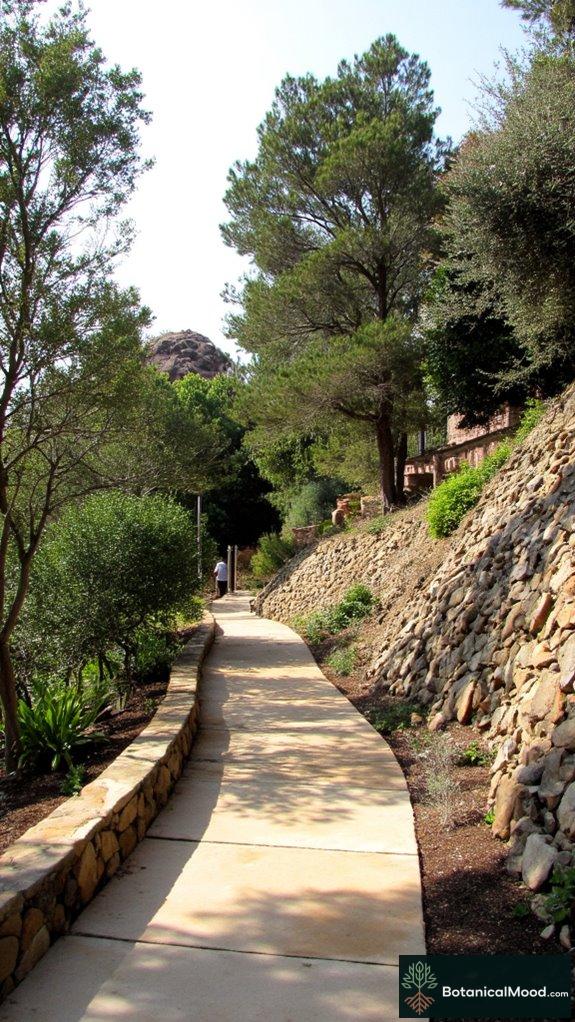
Creating a successful slope terrace requires meticulous planning and a keen understanding of the terrain’s dynamics, as every angle and elevation can dramatically influence moisture retention and drainage patterns.
When designing, consider slope orientation and how it affects sunlight exposure and water runoff. Think about the design aesthetics, blending functionality with visual appeal for a harmonious garden. It’s also essential to guarantee sturdy retaining walls, using materials such as stone or treated timber, to prevent erosion. Incorporating modern terraced garden design can also enhance the visual appeal while solving practical issues related to slope management.
Here’s a quick reference table to keep in mind:
| Aspect | Consideration |
|---|---|
| Slope Orientation | Sunlight exposure |
| Materials for Walls | Stone, treated timber |
| Drainage Solutions | French drains, dry wells |
| Plant Selection | Native, drought-resistant flora |
These elements will help create a safe and stunning terrace.
Step-by-Step Construction Techniques for Effective Terracing

To initiate an effective terracing project, it’s essential to fully understand the sequential steps involved, as each phase builds upon the previous one and contributes to the overall stability and aesthetic of the structure.
First, gather your construction tools, such as shovels, levels, and trowels, to guarantee precise measurements. Next, select durable terrace materials—like timber, stone, or concrete blocks—that match your design vision and local climate.
After marking your layout, begin excavating, guaranteeing proper drainage for longevity. As you build the first tier, compact materials firmly to prevent settling.
Follow this method for each additional level, always checking alignment with a level.
Selecting the Right Plants for Staggered Terraces

Selecting plants for staggered terraces isn’t merely an afterthought; it plays a significant role in the overall design and functionality of the garden. Thoughtful plant selection guarantees stability and enhances beauty, while incorporating companion planting principles can promote a healthier ecosystem.
Here’s a table of plants that work well together:
| Plant Type | Companion Plant |
|---|---|
| Lavender (Lavandula) | Rosemary (Salvia rosmarinus) |
| Sedum (Sedum spp.) | Thyme (Thymus spp.) |
| Marigold (Tagetes) | Basil (Ocimum basilicum) |
When you choose native species or drought-tolerant varieties, you’re not only promoting sustainability but also cultivating a safe environment. Using these strategies, I’ve transformed my own terraces into thriving biodiversity hubs, showcasing both functional aesthetics and ecological balance.
Enhancing Soil Stability With Ecological Practices

While it may not seem obvious at first, enhancing soil stability through ecological practices is fundamental to maintaining the integrity of tiered gardens.
By prioritizing soil conservation, I’ve found that incorporating native vegetation, such as Salvia nemorosa or Echinacea purpurea, greatly benefits these gardens. Their deep root systems not only help anchor the soil but also retain nutrients and moisture, reducing erosion.
Additionally, using organic mulches can further improve soil structure, allowing for better water infiltration and support for my garden’s overall health.
Noteworthy Examples of Terraced Landscape Design

Terraced terrains not only maximize space in hilly environments but also showcase the beauty of nature’s contours through thoughtful design and plant selection. I’ve often found inspiration in remarkable projects that blend urban terracing with historical vistas, creating living art.
| Project Name | Description |
|---|---|
| The Hanging Gardens | Famed for its lush vegetation and complex levels, this ancient wonder represents a historical marvel. |
| Gardens by the Bay | Showcases urban terracing with sustainable practices, integrating native flora and safety features. |
| Mount Eden | A historic site in New Zealand, exemplifying terraced agriculture with an emphasis on heritage crops. |
| Sasaki Gardens | Merges modern design with careful terracing, emphasizing biodiversity in urban settings. |
These examples help remind us how beautifully effective terracing can be while embracing a sense of safety and ecological mindfulness.
Sustainable Water Management in Terraced Gardens
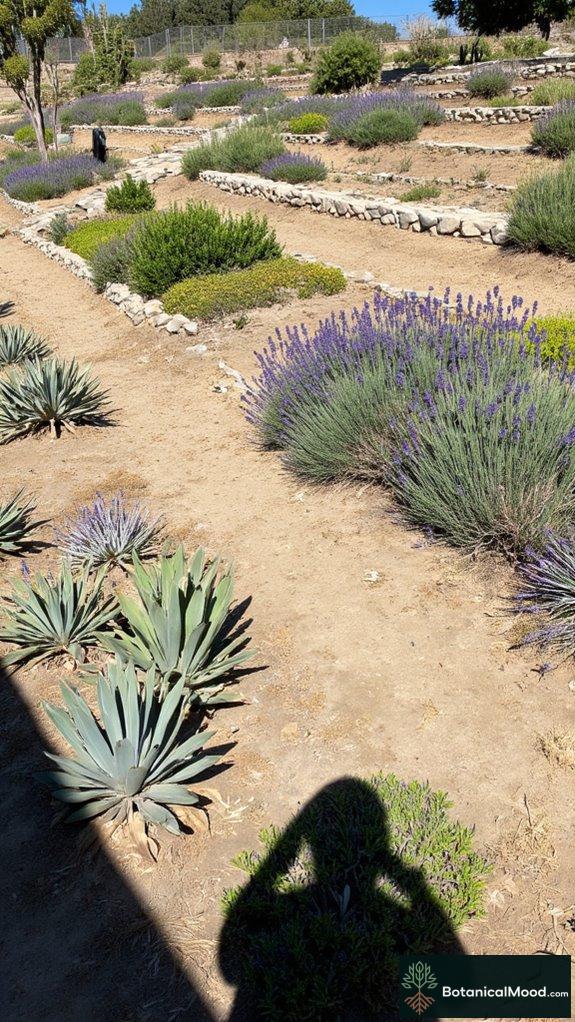
How can we guarantee that our terraced gardens thrive while conserving precious water resources? One effective approach is rainwater harvesting; by installing a system, we can collect and utilize rainwater, reducing dependency on municipal sources and guaranteeing our plants receive the moisture they need.
Coupling this technique with drought resistant plants, such as Agave americana or Lavandula angustifolia, we can create a sustainable oasis. These plants not only minimize water requirements but also provide stunning textures and vibrant blooms, enhancing the garden’s aesthetics.
Carefully designing our terraces with proper drainage guarantees that rainwater is efficiently directed to roots, safeguarding our garden’s health.
In doing so, we contribute to both ecological conservation and transformative beauty, inspiring a balanced relationship with nature in our outdoor spaces.
Innovative Drainage Solutions Showcased

Creative design choices in eco-friendly gardening not only enhance aesthetic appeal but also play an integral role in effective water management. Employing innovative drainage solutions, like French drains that reroute excess water, I’m establishing drainage strategies that prioritize soil stability and eliminate waterlogging.
I love utilizing dry wells to manage significant runoff, allowing for natural infiltration over time.
For surface solutions, dry creek beds mimic nature’s flow, guiding water while adding charm to the scenery.
Permeable retaining walls, incorporating gravel gaps, are another favorite, facilitating water passage and reducing pressure buildup. These innovative designs maintain safety in my garden, guiding moisture and protecting plants like Echinacea and Verbena without sacrificing beauty. Effective drainage solutions are essential for preventing soil erosion and preserving the health of my garden.
Together, they create a sustainable haven I cherish.
Terracing for Erosion Control
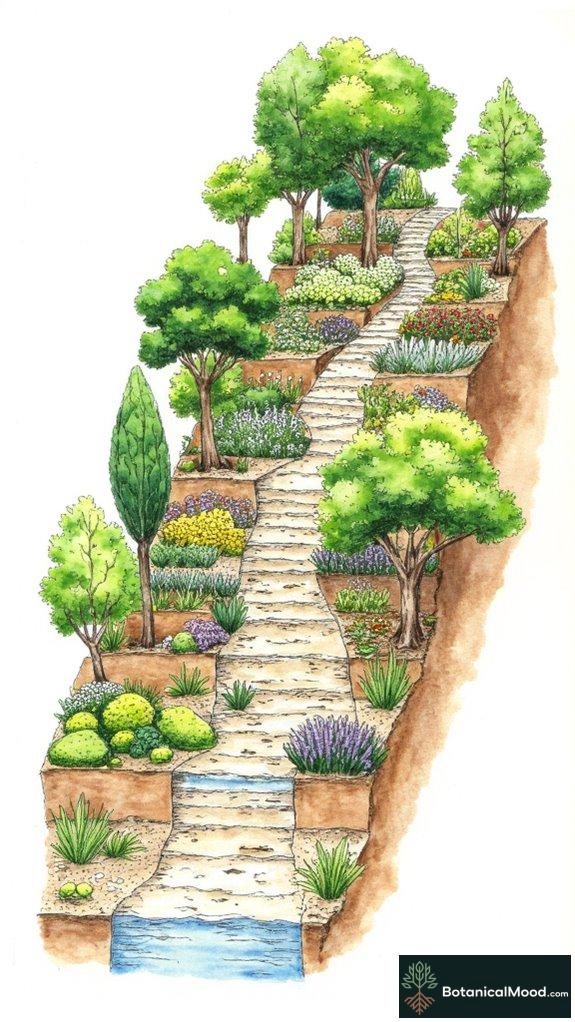
Erosion can wreak havoc on garden terrains, and while I often marvel at the beauty of slopes adorned with flora, I’ve learned that careful planning through terracing can greatly mitigate these challenges.
By implementing terracing, I’ve witnessed erosion metrics improve dramatically. For example, traditional bench terracing can reduce soil loss by approximately 75%, while some tropical methods even showcase a staggering 93% reduction! This transformation allows me to visualize the benefits clearly, as terraces promote water retention and enhance soil quality.
Furthermore, good design and maintenance are essential. With adequate spacing and regular checks, I guarantee my terraces function effectively, providing a safe, sustainable environment for my cherished plants.
Embracing terracing has truly redefined my garden’s resilience.
Meet the Garden Visionary

Powell, hailing from California, started on her garden journey with a desire to blend nature seamlessly into her urban environment, fostering tranquility and sustainability in her everyday life.
To achieve this vision, Powell undertook a meticulous design process, drawing inspiration from renowned figures like Piet Oudolf while integrating the principles of naturalistic planting.
She collaborated with LOLA Garden Designers to develop sophisticated planting plans that emphasize both aesthetic beauty and ecological function, ensuring a thriving ecosystem.
Using tools from brands like Fiskars and accessories from Gardena, Powell crafted her designed garden with precision.
Partnering with local horticulturists and specialists, she selected native plants that align with her sustainable philosophy, resulting in a harmonious outdoor space that invites wildlife and promotes biodiversity.
Iconic Terraced Landscapes Worldwide

Terraced views, as one may observe, represent an extraordinary blend of innovation and tradition, showcasing humanity’s profound relationship with the earth.
Take, for example, the stunning Banaue Rice Terraces in the Philippines, an emblem of cultural heritage preservation and sustainable terraced agriculture practices. Similarly, the Longsheng and Yuanyang Terraces in China reveal engineering brilliance achieved over centuries, where rice cultivation thrives in steep elevations.
In Peru, the Inca Pisac terraces amplify indigenous farming techniques while inviting tourists to appreciate their historical significance.
Meanwhile, Japan’s Tanada Paddy Fields, with their shimmering water mirrors, enrich local communities through agrarian artistry.
Finally, Bali’s Jatiluwih and Tengallalang Terraces embody the spirit of eco-friendly tourism, blending spirituality with sustainable agricultural practices, ensuring these environments remain cherished and safe for future generations.
Summary
Transforming my sloped land into a terraced garden has been a rewarding adventure. I blend native plants like lavender with eco-friendly practices, creating a beautiful space that flourishes sustainably. Each layer is a piece of art, making my garden both functional and inviting.
I’d love to hear about your own experiences with terraced gardening. What challenges did you face, and how did you overcome them?
Please share photos of your garden and tell us how you designed it!
References
- https://www.backyardboss.net/create-a-terrace-garden-in-a-sloped-yard/
- https://urbanoasiscontracting.com/slope-landscaping-austin-smart-terracing-drainage-plants/
- https://tamuradesigns.com/terracing-a-backyard-slope/
- https://gardenculturemagazine.com/guide-to-terrace-gardening/
- https://mcleodlandscaping.com/how-to-landscape-a-steep-slope-without-retaining-walls/
- https://dirtlocker.com
- https://permies.com/t/55668/Comprehensive-Sepp-style-terracing
- https://www.youtube.com/watch?v=IjjhKZ4F6W8
- https://urban-earth.co.uk/sloped-garden-ideas/
- https://salcorplandscaping.com/sloped-yard-drainage/
- https://www.kglandscape.com/sloped-property-drainage
- https://tamuradesigns.com/patio-drainage-solutions/
- https://www.houzz.com/magazine/4-gardens-with-creative-earth-friendly-drainage-solutions-stsetivw-vs~134509439
- https://blog.landscapedrains.com/11-decorative-drainage-ideas-for-your-outdoor-spaces
- https://cclandscapes.ca/yard-drainage-solutions/
- https://iahs.info/uploads/dms/5647.23-31-137-Lal.pdf
- https://scholarworks.uni.edu/cgi/viewcontent.cgi?article=1878&context=pias
- https://www.srs.fs.usda.gov/pubs/ja/2016/ja_2016_sun_010.pdf
- https://www.ecorisq.org/docs/Dorren_Rey.pdf
- https://pubmed.ncbi.nlm.nih.gov/32980637/



